 The 2014 edition of the Gutsy Walk, a fundraising walk organized by Crohn’s and Colitis Canada (CCC) to raise the public’s awareness of IBD and to support scientific research for Crohn’s disease and ulcerative colitis, has raised $3,004,624 — an amount that will go towards helping 233,000 Canadian patients with IBD-related diseases.
The 2014 edition of the Gutsy Walk, a fundraising walk organized by Crohn’s and Colitis Canada (CCC) to raise the public’s awareness of IBD and to support scientific research for Crohn’s disease and ulcerative colitis, has raised $3,004,624 — an amount that will go towards helping 233,000 Canadian patients with IBD-related diseases.
As reported by Tim Sandle to the Digital Journal, this year, 15,000 participants walked across 59 communities in Canada, the country with one of the highest IBD rates in the world, explained Lindee David, Crohn’s and Colitis Canada CEO, on the day of the event, adding that this year’s edition of the Gutsy Walk was “an incredible opportunity for us to walk together – uniting patients, their families and supporters.”
CCC’s goal is to find a cure for these two diseases and to improve the quality of life of IDB patients, which can be affected not only in terms of health, but also on a daily basis, due to the disease’s symptoms and frequent hospital visits.
Crohn and Colitis are chronic diseases of the intestines that cause inflammation due to a disorder in the human immune system. Symptoms like diarrhea, rectal bleeding, abdominal pain, and constipation, among others, are similar in both Crohn’s and colitis, but the affected areas of the GI tract are different. Crohn’s most commonly affects the ileum and the beginning of the colon, but it may also affect any part of the gastrointestinal (GI) system. Colitis only affects the colon, also called the large intestine.
One out of 150 Canadians suffers from one of these diseases. Canadian children are the most affected demographic in the country, and the number of them suffering from these diseases has doubled since 1995. IBD is also affecting new families, who are developing Crohn’s and colitis often within the first generation.
Gutsy Walk started in 1996 in 24 communities and has raised $29 million since then, ranging from $280,000 to $3 million per year to be applied to education and scientific research. Last year, 36 projects were supported by these funds.

